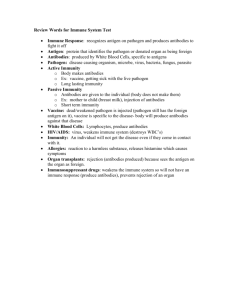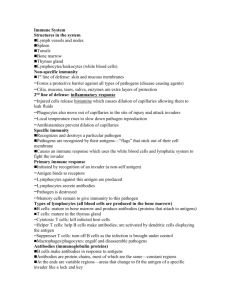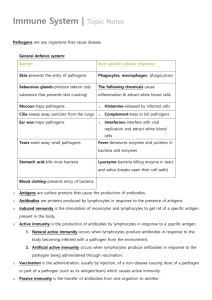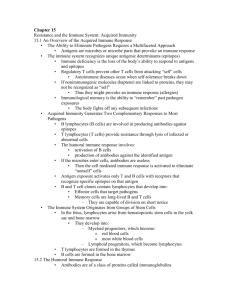View Revision Note
advertisement
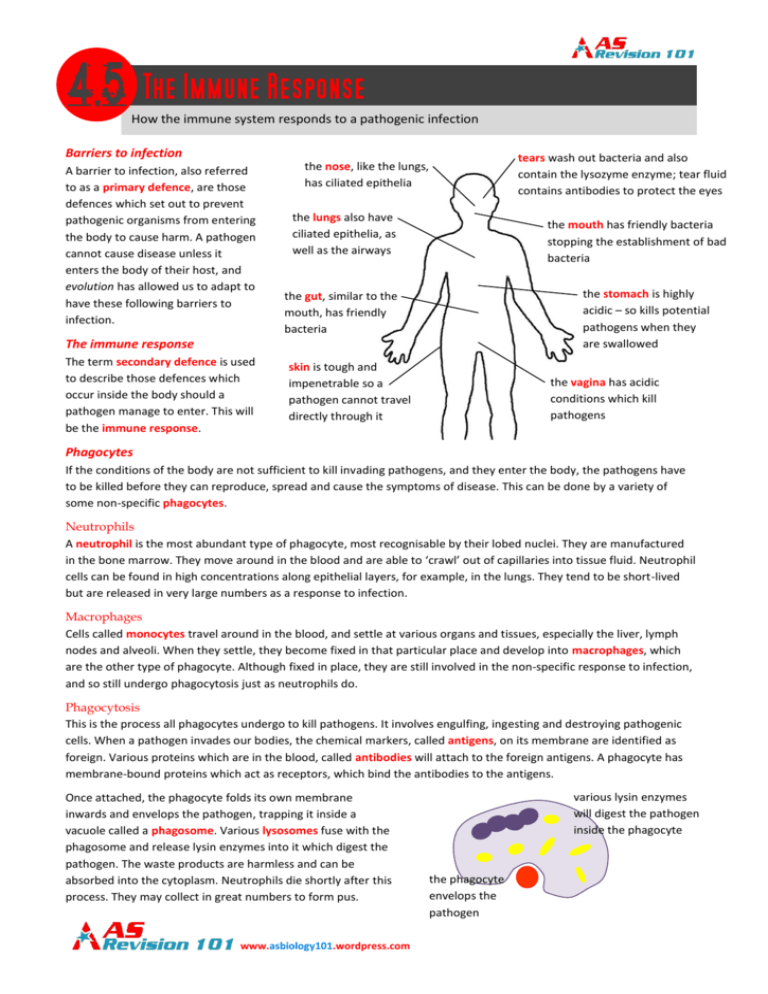
How the immune system responds to a pathogenic infection Barriers to infection A barrier to infection, also referred to as a primary defence, are those defences which set out to prevent pathogenic organisms from entering the body to cause harm. A pathogen cannot cause disease unless it enters the body of their host, and evolution has allowed us to adapt to have these following barriers to infection. tears wash out bacteria and also contain the lysozyme enzyme; tear fluid contains antibodies to protect the eyes the nose, like the lungs, has ciliated epithelia the lungs also have ciliated epithelia, as well as the airways the mouth has friendly bacteria stopping the establishment of bad bacteria the stomach is highly acidic – so kills potential pathogens when they are swallowed the gut, similar to the mouth, has friendly bacteria The immune response The term secondary defence is used to describe those defences which occur inside the body should a pathogen manage to enter. This will be the immune response. skin is tough and impenetrable so a pathogen cannot travel directly through it the vagina has acidic conditions which kill pathogens Phagocytes If the conditions of the body are not sufficient to kill invading pathogens, and they enter the body, the pathogens have to be killed before they can reproduce, spread and cause the symptoms of disease. This can be done by a variety of some non-specific phagocytes. Neutrophils A neutrophil is the most abundant type of phagocyte, most recognisable by their lobed nuclei. They are manufactured in the bone marrow. They move around in the blood and are able to ‘crawl’ out of capillaries into tissue fluid. Neutrophil cells can be found in high concentrations along epithelial layers, for example, in the lungs. They tend to be short-lived but are released in very large numbers as a response to infection. Macrophages Cells called monocytes travel around in the blood, and settle at various organs and tissues, especially the liver, lymph nodes and alveoli. When they settle, they become fixed in that particular place and develop into macrophages, which are the other type of phagocyte. Although fixed in place, they are still involved in the non-specific response to infection, and so still undergo phagocytosis just as neutrophils do. Phagocytosis This is the process all phagocytes undergo to kill pathogens. It involves engulfing, ingesting and destroying pathogenic cells. When a pathogen invades our bodies, the chemical markers, called antigens, on its membrane are identified as foreign. Various proteins which are in the blood, called antibodies will attach to the foreign antigens. A phagocyte has membrane-bound proteins which act as receptors, which bind the antibodies to the antigens. Once attached, the phagocyte folds its own membrane inwards and envelops the pathogen, trapping it inside a vacuole called a phagosome. Various lysosomes fuse with the phagosome and release lysin enzymes into it which digest the pathogen. The waste products are harmless and can be absorbed into the cytoplasm. Neutrophils die shortly after this process. They may collect in great numbers to form pus. www.asbiology101.wordpress.com various lysin enzymes will digest the pathogen inside the phagocyte the phagocyte envelops the pathogen Lymphocytes The immune response is the initiation of the specific response to an infection. Whereas phagocytes are non-specific, the immune response involves the activation of lymphocytes in the blood to help fight a disease. Macrophages actually play an important role in triggering the immune response. When cells are infected, they release chemicals which attract neutrophils to the area. One such chemical is histamine, which also makes capillaries more leaky as a result of its release. This means more fluid leaves the capillaries in the area of infection, so more tissue fluid passes into the lymphatic system. This leads the pathogens towards macrophages which wait in the lymph nodes. Lymphocytes also come in two varieties: B lymphocytes (B-cells) and T lymphocytes (T-cells). B lymphocytes produce antibodies which stick to an antigen. Antibodies and antigens Antigens are present on the invading pathogens. They are recognised by our bodies as foreign, and this is what triggers the immune response. Our own ‘good’ cells have antigens on them, but we can successfully recognise them as our own, so they do not cause an immune response. An antigen has a specific shape to the cell it is for. A foreign antigen stimulates the production of antibodies from the B lymphocytes. These antibodies are specific to the antigens on the pathogen. An antibody is a protein with a quaternary structure and is sometimes referred to as an immunoglobulin. The immune system needs to manufacture an antibody for each antigen recognised by the immune system, so the antibodies can attach to the antigen, rendering them harmless. ‘light’ polypeptide chain ‘heavy’ antigen polypeptide chain disulphide bridges S S S S binding site antigen binding site The diagram above shows the structure of an antibody. It consists of four polypeptide chains, two of which are light polypeptide chains and two of which are heavy polypeptide chains. Each of the chains is held together by disulphide bridges. Every antibody shares the same ‘constant’ part of the protein, but the ‘variable’ part is specific for its complementary antigen. This structure of the variable section is dependent upon the amino acid sequence. Neutralisation Antibodies work in three main ways. One way involves the antibody attaching itself to the antigen on a pathogen. The antigen may be a binding site to bind with the host cell to infect it, so if the antibody does this, it renders the pathogen harmless as it cannot attach to a host cell. This is called neutralisation. antigen pathogen www.asbiology101.wordpress.com antibody Agglutination Some larger antibodies might not have that fixed Y-shape as seen above. They can have the appearance of multiple Yshaped antibodies glued together, with many specific variable regions. Multiple binding sites can mean that an antibody is able to attach to several pathogens, which brings many pathogens together in clumps. This has two benefits: firstly, the pathogens cannot enter host cells because they are in large clumps and have been effectively ‘paralysed’ by the antibody; but also it leads to more efficient phagocytosis, because when the pathogens are in clumps, it is easier for the phagocytes to engulf more microbes. pathogen large antibody Lysis The third way in which antibodies can perform their jobs is by binding to antigens whereby the binding action activates proteins in blood plasma which then digest bacterial walls. This will kill the invading cells. The cell-mediated immune response (what T-cells do) The immune response occurs as a reaction to an invasion of pathogens. The response produces antibodies to fight off the pathogens, but also is designed to provide long-term immunity. Immunity is given after becoming infected and the right antibodies being produced, through immunological memory (i.e. your immune system remembers those antibodies so future pathogens can be recognised and stopped immediately). The cell-mediated immune response is the immune response of the T-cells. Pre-infection T-cells with various receptors Clonal selection T-cell encounters its complementary antigen: - on a cell infected with a virus - or on an APC (antigen-presenting cell) - or actually stuck to the pathogen Clonal expansion and differentiation T-memory cells these stay in the body to provide long-term immunity, for any period up to a lifetime divides by mitosis T-helper cells produce cytokines that stimulate the B-cells to develop and for the phagocytes to undergo phagocytosis (i.e. stimulate the rest of the immune system) www.asbiology101.wordpress.com T-killer cells bind to cells carrying the antigen and produce toxic chemicals (peroxides) which kill the infected body cells As you can see, the cell-mediated response does not involve antibodies. The process of clonal selection is simply the selection of the correct T lymphocytes. But before the T lymphocytes can be effective in fighting the disease, they must increase in their numbers, and so they undergo clonal expansion where they divide by mitosis (clone) a number of times. T-cells develop, or differentiate, into three different types of cell: T-helper (Th) cells release cytokines, which are chemical messengers, which stimulate the rest of the immune system – this involves encouraging the B-cells to develop and for phagocytosis to be undergone by phagocytes T-killer (Tk) cells can bind to the pathogens which have the antigens, and they produce peroxides – toxic chemicals – which will destroy the invading cells and infected body cells T-memory (Tm) cells, which are one type of memory cell which provides long-term immunity (with T-cells, this type of immunity is called cell-mediated immunity) The humoral immune response (what B-cells do) The humoral response is that of the B-cells in the immune system. The diagram below outlines the various stages involved in the humoral response. This response does use antibodies in order to provide immunity. The type of immunity given from this response is called humoral immunity. Pre-infection B-cells with various receptors Clonal selection receptor binds to an antigen on a pathogen (or antigenpresenting cell – APC) Clonal expansion and differentiation divides by mitosis some become memory cells which persist for many years and give immunity to the disease caused by the pathogen some differentiate into plasma cells which produce antibodies antibody B-cells undergo the same clonal selection and clonal expansion processed as T-cells do. However, the differentiation stage is different. There are only two types of cell B-cells can differentiate into: plasma cells which flow around in the blood and can produce the specific antibodies whenever required B-memory cells, the other type of memory cell to T-memory cells, which provide the humoral immunity Is it important to understand that both types of lymphocyte (B lymphocyte and T lymphocyte) differentiate because they are manufactured originally from stem cells in bone marrow. These cells are unspecialised, which allows them to differentiate to a more specific type of cell to perform a particular function. www.asbiology101.wordpress.com



